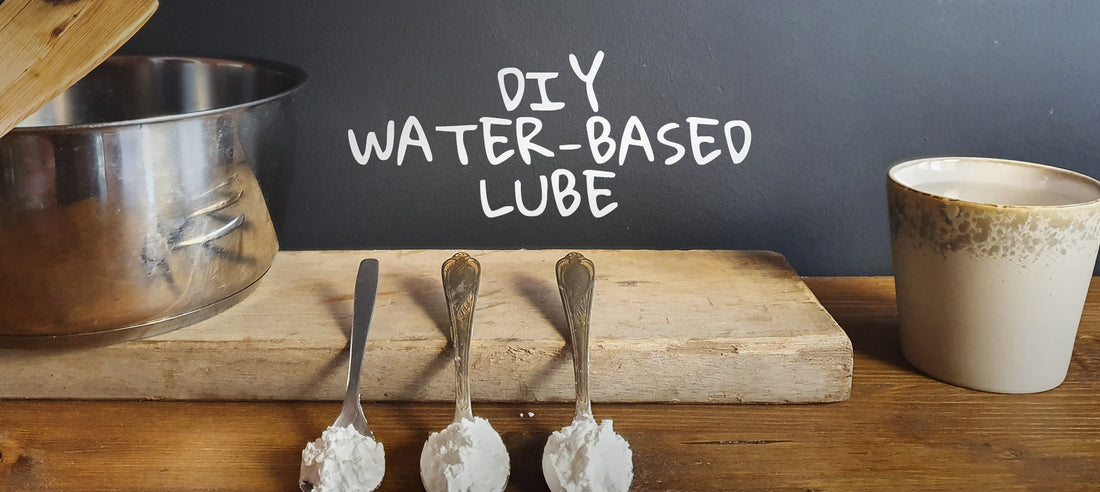As we’ve already taken plastic out of periods since Ruby Cup’s launch more than a decade ago, we’re this Plastic Free July exploring other ways to avoid plastic. Last week, we launched an article on how you can use your menstrual blood as a zero waste plant fertilizer providing your plants with phosphorus, potassium and nitrogen. This week the time has come to looking into making our own water-based lubricant as a zero waste alternative to store-bought lubes in plastic tubes.
If you are new to menstrual cups and plastic free periods and above all, if you have never had penetrative sex or inserted anything into your vagina, you might want to have some lube around the first time you insert your cup. You’ll potentially have to move the cup around a bit and try inserting it several times and experiment towards finding its proper placement in the lower part of your vaginal canal. This can all be easier if your vaginal area is a bit moist. In order to have a smooth first-time experience with a menstrual cup, simply apply a bit of water-based lube to the rim of the cup right before insertion.
Lubricant can also benefit you during sex or masturbation, especially if you experience vaginal dryness. In other words - there are various situations where having some lube handy can be beneficial.
These were our requirements for a good, DIY zero waste lube
More than ready to make and test our own DIY lube, we were scrolling the internet for do’s and don’ts on the outlook for the perfect recipe.
- It had to consist of simple ingredients not wrapped in too much packaging
- It had to be pretty easy to make
- It had to be water-based
- It should (preferably) be cheap to make.
And yes, all of this is possible. Having browsed through various options, we’ve landed at a corn-starch and water-based lube recipe that (in different versions) seems to have already taken parts of the internet by storm. We are probably a bit late to the party. Nevertheless, you could be too, and the zero waste lubricant could be your next DIY game changer.

Making your own lube comes with great benefits:
- Not only is it cheap
- You’ll know exactly what natural ingredients you’ve put into it (and thus inside your vagina! No parabens, fragrances, other chemicals, etc.)
- And you’ll know that it doesn’t come in a plastic tube that you’ll afterwards have to discard.
Your lube needs to be water-based
No matter if you go for our recipe below, or you want to try out another DIY lube, make sure that the version you choose is totally water-based and contains absolutely no oil. Just like any other product in medical grade silicone, you’ll want to keep your Ruby Cup away from oil-based lubricants or lotions in order to make it last its full lifespan of 10 years.
If you are not planning to use the lube with a menstrual cup but with condoms or sex toys, the case is the same. Water-based (and also silicone-based) lubes go with latex condoms, whereas oil can break down the latex. With sex toys you should also go for water-based lube, otherwise the toys can also start to break down. Medical News Today announces water-based lubes as “typically the safest option for intercourse and masturbation”. The medical news site also mentions a potential downside to bear in mind, though: “One disadvantage is that water-based lubes can dry out fairly quickly. However, someone can simply reapply more when needed.”
As long as you make sure to have enough lube handy for reapplication, the positives by far outweigh the negatives. Vaginal health comes first!

Let’s get to it: DIY zero waste water based lube recipe
Ingredients:
1 cup of water
3 heaping teaspoons of cornstarch
Equipment:
Small pot or saucepan
Whisker/cooking spatula
Stove
Preparation time:
5-8 minutes + 10 minutes for cooling down
Preparation:
First, make sure that the equipment (pot, whisker/cooking spatula) is clean. It’s important to avoid any bacterial contamination at any point in the process. Then heat the water in the saucepan until lukewarm or even a bit more, and take it off the heat for a while while dissolving the cornstarch into it.
Stir very well for mixing the cornstarch and the water completely until you have a milk-like white liquid. When mixed, you place the pan on the heat again and let the temperature go up while continuously stirring until the mix becomes a lube. Depending on how hot your pan is, this could take around 2-3 minutes (longer if your pan is less hot). Try not to get the mixture boiling, as this will potentially create lumps in the mix.
When your DIY lube has the consistency you like, take it off the heat and keep on stirring it every now and then while it cools down, around 10 minutes. It’s naturally a bit thicker in its cold form than when warm, so take it off the heat when you feel that “it’s almost exactly as it should be”.
The result:
Your very own, homemade DIY zero-waste water-based lubricant. It’s whitish, not clear as the store-bought ones. And it comes in the consistency you like (heat for a shorter time if you want it more liquid, for longer if you want it thicker).
Condom compatible | Sex toy compatible | Biocompatible (Body-friendly) | Menstrual cup compatible.
And safe: “Cornstarch and water is a generally safe, and well-tolerated, water-based lubricant option” - Caitlin V, Sexologist, researcher and coach.
Store your DIY lubricant at room temperature. Try to use it within a few days for it not to go bad (you’ll know it is starting to turn bad when it gets a yeasty smell to it).
If we have saliva available, do we need another zero waste lubricant?
At first glance, spit could seem to be the perfect zero waste lubricant. No packaging, no preparation needed, always at hand. And pretty water-based too, right? Kinda, yeah, but saliva also contains uric acid, enzymes, cholesterol and mucus-forming proteins. Several sources warn that saliva should not be used as a lubricant.
“The bacteria present in your saliva has the potential to cause a yeast infection by altering the vaginal microbiome” - India Times.
“Just like any other fluid, it has the tendency to spread infection” - Dr Niveditha Manokaran on Healthshots.
“There is a risk that someone could pass or receive a sexually transmitted infection” - Medical News Today.
 Your Account
Einloggen
Your Account
Einloggen
 Basket
Basket



